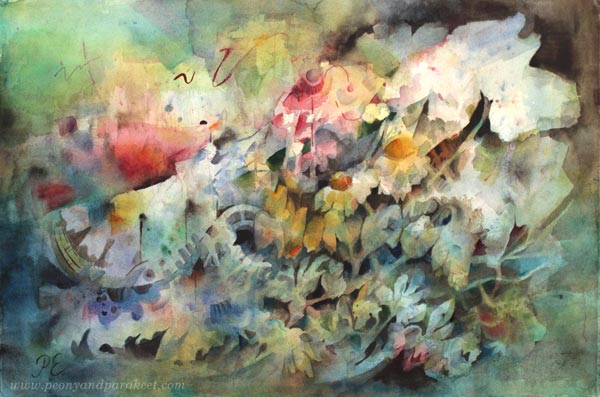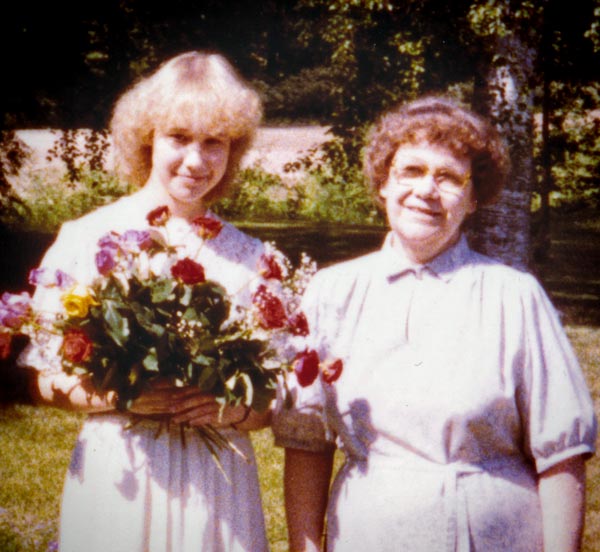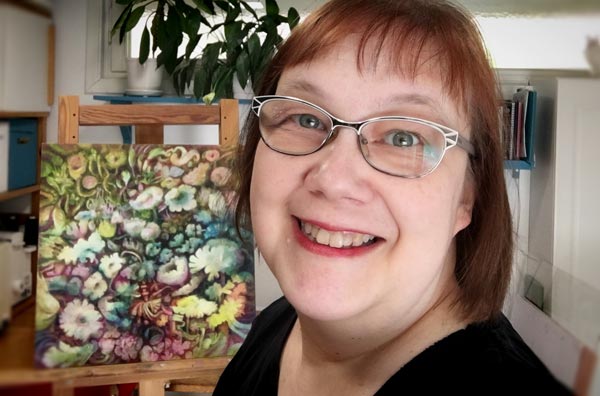Why I Paint White Flowers – How Your Artistic Voice is Influenced by Others
There’s a lot of talk about finding your artistic voice, but very little about how other people affect it. So this week, I share a story about my mother and her influence on my art.
Painting the Same Thing Again and Again
A couple of days ago, I was on a morning walk near my home in Southern Finland. The air was fresh as well as the view, dominated by the blue sky and white clouds. My beagles’ busy noses and a glimmering brook followed a sown field that had already started to green. Both birds and earphones fed entertaining listening. But all I could think of was my painting. Was it finished? Should I add more color to the flowers? What else did I need to adjust to make most of the tens of hours? I was alone with my dogs, but the inner critic kept me company: what kind of artist doesn’t even know the meaning of her images?

Yes, I am no artist at all. I paint white flowers, the easiest anyone can imagine, and the worst that my mother knew. “No white flowers,” she repeated to my father when her wedding anniversary came close, and he was about to buy a bouquet. “White flowers mean death.” And now, long after she has passed away, all I want to paint is white flowers.



Commenters are Your Art Coaches
Rebelling had no place in my upbringing during the 1970s and 1980s. As a teenager, I tried to respond to my mother’s corrections and criticism with an ignorant smile. Not for long. She didn’t hesitate to tell that it wasn’t a proper reaction. She was both a direct and shy person. Her presence was almost invisible in public gatherings, but at home, in her empire, she was the master of rights and wrongs. So when I showed drawings to her, she either approved or disapproved. She didn’t talk to me as directly as to my father – what to do or what not – but her words and facial expressions told everything.
My mother was like a strict gymnastic coach with high expectations, but she lacked one essential skill – the ability to show how the tricks could be done. She was as honest to herself as to anyone in this matter and put her energy for finding time, supplies, and art education for me. Time to create was the easiest part. My mother was a housewife. She had left her job at a young age right after she got married. She didn’t want her daughters to have the same destiny, so she did her best to keep me out of the kitchen and constantly reminded me how children would prohibit me from doing what I love.

We lived in a small town near the Russian border, and our family wasn’t wealthy. The only income came from my father’s pension. In the evenings, my mother wrote all the expenses on a small black book. But purchasing pens and paper was mandatory. To her, it was the lowest level of civilization, more important than books. Our town had one bookshop that sold some supplies, but after we got more knowledge from local art groups and competitions, it became evident that I needed a better and broader selection. So every month, when my parents drove to a bigger town, I was often with them, selecting paper, paint boards, crayons, and acrylic paints from a real art supply store.
A Praised Piece Sticks into Your Mind
When I was some years over ten, in one spring morning, I decided to try out a new set of crayons. It was just a warm-up, a quick landscape without using any reference. “Look, mother, what do you think,” I said like so many times before. She looked at the image, tightened her lips, but unlike her, she didn’t say much. Later, when I opened a narrow kitchen closet to pick an iron, I stopped. The landscape was taped inside the wooden door. “I like to look at it,” she said after seeing my puzzled face.

I was devastated. That little landscape didn’t deserve the place. So many times I had poured my heart out on paper and soon found out that it wasn’t to her liking. And now – I didn’t even color all the paper!
Finding the Why Behind Your Artistic Voice – Connecting the Appraisals and Repetitions
Fortunately, my mother was not the only one commenting on my art. My two big sisters had different opinions, and my teachers and friends as well. One piece didn’t satisfy them all, but there were always kind words from someone. It encouraged me to keep painting and drawing, as everyone, especially my mother, expected.
After my mother’s death, one stormy weekend, I traveled to the childhood home to pick things that I wanted to keep before we would sell it. The house was cold, but I knew it was the last time when I would see it like it used to be. Everything was clean and tidy. Performing tasks effectively with high quality had always fascinated my mother. “If I could choose what my profession was, it would be a researcher of work – if such a profession existed.”
When I got up the stairs to an attic, the sight would surprise anyone but me. The attic had always been nearly empty. In one corner, under a sloped sealing, my father had built a small closet for safe storage. I opened its little door, and there they were, neatly in a big cardboard box – my paintings and drawings. Not all, but a collection that my mother had curated over the years, the little crayon drawing included.
So a few days ago, when I was walking by the field and looking up in the sky, my mother came to me in the form of the freshly colored landscape. I now knew that my urge to paint white flowers hadn’t been an act against my mother, but a yearn for her acceptance that blank white blobs had once given to me. Now my question is: can I let go of them, or do I want to keep her in my art forever.

Who has influenced your art? Can you recognize how?
P.S. I also teach drawing and painting flowers in the class Floral Fantasies.
From Fact Finding to Quick Start

She searched ideas by watching what others had made. Then she realized that she had spent hours trying to find the inspiration. And it was already too late to start making anything by her own. Besides, she was feeling overwhelmed.
Does this sound familiar to you? You might get inspired of this or that, but feel powerless to start making your own. It can be only that you are tired after a long day. Then the best you can do is to go to sleep. But if repeatedly find yourself having difficulties to begin, it might be that you are using the wrong method when searching for inspiration.
Use your imagination when browsing other people’s work.
When you use your imagination, you will get your own, not other people’s ideas. This requires that you do not take anything you see as a fact. Instead, you should focus on the feelings and associations which they raise.

Here’s a crayon drawing which I made as a teenager. It is about a girl coming from the library. The weather is predicting the end of summer.
But actually, you don’t need to know anything like that. The fact that the girl is standing in the middle of the picture should be irrelevant to you too. The purple dress is interesting only if you react to the color. Maybe you are touched by the combination of blue purple and bright yellow? Or maybe you get cold vibes when watching the image? Like when you were sitting on the floor of your new unfurnished home thinking of how to renovate it. Which reminds you of new beginnings and how much hope they hold. A little bit like puppies and young children …
Now you ask: would that mean that I should draw a puppy dog? Or just grab the idea of softness? You could if you feel inspired enough but I would advise you to have a bit larger mix of things. So let’s pick another image.

Here’s another work from decades ago. I used watercolors to replicate a black and white photograph of my grandmother and her three friends. Here you might think how stiff and serious people used to be in photographs. Those forced gestures are a complete opposite for the puppies. How funny the similar photo of four puppies would be!
Now you might get inspired by expressing the two opposites: stiff and free-form, hard and soft. Hard can still be soft inside, like the hearts of the four young girls.
Make a Quick Start using the ideas as a starting point.
When I began working from this standpoint, I knew only this: I would begin with coloring four soft areas and at some point add both organic and angular lines to express the opposites. Then I turned the music on and went with the flow.

In the end, I wrote where my thoughts had led me to: “The sun always rises in the morning”. I had illustrated the change of day and night and expressed how every morning is a new beginning. Now, there’s hardly any resemblance to the images I started with. Still, they gave me a jumpstart on creating.
When browsing, focus on your inner thoughts.
If you get stuck with having no ideas and being overwhelmed by other people’s work, you think too much about facts and give too little value to your inner thoughts. You will browse endlessly because facts never stop if your own thoughts will never get noticed. Instead, look at few images or read few sentences and think: What is here that comes to my mind? What basic combination could I create from these just to get started?
If you look for the perfect inspiration starter, you may never find it. In fact, there’s no such thing. But if you value your own thoughts, creating art will generate happiness regardless of the source of inspiration. Your art journal or any end result will become more and more perfect because you are perfect for yourself.
Subscribe to my weekly emails – Get a free mini-course!